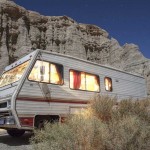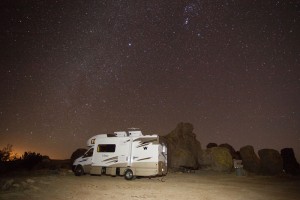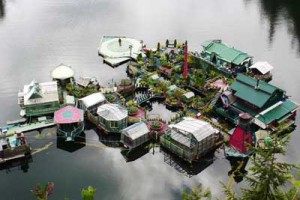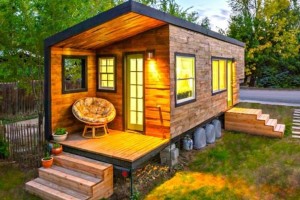I may get commissions for purchases made through links in this post.
The night sky darker than you have ever seen, the stars brighter, the moon looking larger than it does from the city. The smell of baked earth and eucalyptus on the warm night wind.
The roar of a foul-smelling diesel generator, announcing your presence with a rattle that’s audible for half a mile around.
Which one of these things doesn’t belong on your dry camping trip?
Many RV’ers are trading their noisy generators for silent, clean solar panels. After all, you can never get fully off-grid if you need to load up on generator fuel twice a week. And it’s not just an eco-friendly choice: after the initial installation cost, solar power is practically free.
It can feel daunting to get started with solar power. How many panels do you need? Will you need to rewire the whole rig? What happens if it’s cloudy? This article will give a brief overview of the basics of solar energy.
How do solar panels work?
Solar panels use a thin layer of silicon to convert the sun’s energy into electrical power. They do not directly power your electrical equipment – they charge the battery.
There are two equally important halves to a solar rig: charging and discharging. The solar panels charge the battery, aided by a charge controller which regulates the flow of current. To discharge the stored battery power and use it, you’ll need an inverter, which converts DC battery power into a more useful AC format.
Three terms you will often come across are amps (A), watts (W), and volts (V).
Amps measure current, watts measure the rate at which power is used, and volts measure the difference in charge between two points in the system.
Think of your battery as a sink being filled from a faucet. Amps are the water that flows through the faucet and collects in the sink; volts are the pressure in the pipe which pumps the water out; the watts used by your household goods are like the plughole which lets the water run out.
AC and DC – what’s the difference?
The words AC and DC stand for alternating current and direct current. AC is like a ‘wave’ of electricity, flickering rapidly backwards and forwards. It’s what comes through the mains so it’s what most electrical goods run on.
In the USA, mains AC power is 110V or 120V; in Europe, 230V or 240V. Equipment which runs on AC is usually energy-hungry, because mains power is plentiful at home.
DC is like a ‘beam’ of electricity, a single continuous charge. This is the type of electricity you get from a battery. Most RV batteries provide DC power at 12V.
- Built-in RV components – like the lights and water pump – are designed to run directly from the battery, so they use DC power.
- Any three-pronged plug sockets in an RV provide AC, so they can power standard electrical equipment. Sockets that are like car cigarette lighters provide DC.
How much solar power do you need on your RV?
Staying in an RV, you might get by on just a trickle of electricity, or you might use even more than you do at home. It all depends on your lifestyle.
Before choosing solar panels, calculate how much energy you use in a day. Your total energy consumption will be all the power used by your electrical goods, plus a small amount which is used up by things you can’t see (like energy lost within the wires).
The energy consumption of DC electrical equipment is rated in amp-hours – this is, as the name suggests, a measure of how many amps they will use in a single hour. The capacity of your battery is also measured in amp-hours (Ah), with most RV batteries around 70-90Ah. A battery rated 72Ah will be able to power a 1Ah light for 72 hours, or a 12Ah water pump for 6 hours.
AC electrical usage is usually measured in watt-hours (Wh, usually shortened incorrectly to just watts, W), and the watt-hour ratings can usually be seen on the plug casings.
Amps are just watts divided by voltage; in a 12V RV system, you can divide the watt-hour rating of your equipment by 12 to see how many amp-hours it will draw down from the battery. (Some power is lost while converting from DC to AC, so the total amp-hours used by your AC equipment will be around 15% higher than your calculation.)
To calculate the total electricity you use in one day, multiply the amp-hours of each piece of equipment by the number of hours you use it.
For example, if you use a 5Ah phone charger for 2 hours a day, the total energy usage will be 5Ah x 2 = 10Ah.
Add up the amp-hours for all your equipment to estimate your total daily power usage, rounding your answer up to cover any power loss within the system.
If you aren’t sure about the power consumption of all your equipment, there are helpful lists of standard amp-hour ratings online. You can also download worksheets which will help you to calculate your usage.
As a rough rule, one solar panel and one or two batteries will enable you to live a frugal lifestyle – lights, water pump, and not much else. If you’d prefer to use a TV, computer, and microwave, you’ll need two panels and up to four batteries.
To give an idea of what an amp hour “looks like”, here are three rough breakdowns of the power used by three very different RV lifestyles.
Ascetic: running a single overhead light for 2 hours a day (light uses approx. 2 amp-hours, so 4 Ah in 2 hours), plus water pump for 20 minutes (4Ah). No use of the vent fan, and no heating. Charging a phone for 2 hours a day (4Ah) but no other electronic entertainment. About 2Ah will be eaten up by miscellaneous items (like the carbon monoxide detector and clock) and some power will be lost in the system. This eco-friendly lifestyle will take about 10-15Ah/day.
Cautious: running lights for a combined total of 6 hours (12Ah). Using the water pump for 40 minutes (8Ah) and the vent fan for 5 hours (10Ah) every day; 2 hours watching a 12-inch DC TV or 4 hours using a stereo (8Ah); charging a laptop for 2 hours a day (10Ah) and a phone for the same amount of time (4Ah). A frugal lifestyle like this will require around 50-60Ah per day.
Like home: running lights for a combined total of 10 hours (20Ah) and the water pump for an hour (12Ah). Watching a large TV for 4 hours a day (24Ah) and using the microwave for 30 minutes (40Ah). Using your laptop plugged in for 4 hours (24Ah – laptops use more power when plugged directly into the wall than they use to charge the battery). Using the vent fan for 8 hours a day (16Ah). Propane-powered refrigerator and gas stove for cooking. This moderately lavish lifestyle will take 120-150Ah per day.
Most RV batteries can store 70-90Ah. You will need battery capacity to store at least twice as many amp-hours as you use in a day – preferably 3-4 times more than you need. This is because RV batteries can be damaged by running them down below 50% charge, and you’ll also need to keep some backup power for days when the weather is overcast or you use more electricity than usual.
Experienced RV full-timers will point out the importance of having a large battery capacity:
“The secret is that living on solar power off grid is only about battery charging, not just being able to power things in the day time…If the sun has to be shining before you can live, something is wrong.” People without enough battery capacity, he says, “ruin their batteries, and live afraid to turn things on.”
Once you’ve worked out how much electricity you’ll need, it’s time to figure out how many solar panels will provide it.
How much electricity do you use per day?
Staying in an RV, you might get by on just a trickle of electricity, or you might use even more than you do at home. It all depends on your lifestyle.
“Which solar setup you need is based on your electricity usage, plus sufficiently extra to not drain your batteries (and keep them from breaking).”
Before choosing solar panels, calculate how much energy you use in a day. Your total energy consumption will be all the power used by your electrical goods, plus a small amount which is used up by things you can’t see like energy loss within the wires.
The energy consumption of DC electrical equipment is rated in amp-hours – this is, as the name suggests, a measure of how many amps they will use in a single hour.
The capacity of your battery is also measured in amp-hours (Ah), with most RV batteries around 70-85Ah. So a battery rated 72Ah will be able to power a 1Ah light for 72 hours, or a 12Ah water pump for 6 hours.
AC electrical usage is usually measured in watt-hours (Wh, usually shortened to just watts, W), and the watt-hour ratings can usually be seen on the plug casings.
Amp-hours are just watt-hours divided by the voltage, so in a 12V RV system, you can divide the watt-hour rating of your equipment by 12 to see how many amp-hours it will draw down from the battery.
(Some power is lost while converting from DC to AC, so the total amp-hours used by your AC equipment will be around 15% higher than your calculation.)
See my own setup and how it works out so far for me at the end of this page
About solar panels
You don’t just need big batteries, you need solar panels to fill them up. Your panels will need to be powerful enough to easily replace the energy you use, or your batteries will gradually run down.
On the other hand, it’s pointless to install so many solar panels that your batteries are fully charged an hour after sunrise, because for the rest of the day that sophisticated electrical equipment will be sitting on your RV roof gathering dust.
Solar panels are rated in watt-hours (how many watts they produce in an hour) and volts (how hard they ‘push’ electricity through the system). As with AC equipment, divide by 12 if you want to turn their watt-hour production into amp-hours.
Solar panels produce the maximum amount of power when the sun is bright and directly overhead. During summer in the southern US, you might get 5-6 hours a day of ideal strong sunlight, but as little as 1-2 hours a day during winter in the north.
Panels will still produce power when the weather is overcast, but the amount varies – some panels will suffer only a small dip in output, while others will produce only a trickle of power on cloudy days.
The general rule of thumb is to roughly match the amp-hour capacity of your batteries to the watt-hour capacity of your solar panels – so if your batteries have a combined storage of 120Ah, you will want panels with a total rating of around 120Wh. (I didn’t stick to this rule by the way)
Solar panels produce around 60-70 watt hours per square metre, so there is a limitation to how much energy you can produce: how big is your roof? For reasons of practicality, most people install a few identical small solar panels rather than one enormous one.
Panels need to be positioned carefully in full sunlight to maximize their power production. Even a tiny patch of shade – for example, the shadow of a TV antenna – will make most solar panels cut off entirely.
There are also portable solar panels available – the panel unfolds like a picnic table and you prop it on the ground next to your RV. Portable panels are usually less efficient than fixed panels, but they are an easy-to-use introduction to solar power if you’re off-grid for short periods of time.
A solar panel with a rating of 12V can usually produce up to 18V in strong midday sunlight. 12V is just an average output. For this reason, you’ll need to attach a charge controller to your panels to protect your battery from power surges.
How to choose a solar panel for your RV
There are a wide range of solar panels on the market and costs can vary widely. Apart from the obvious concerns – wattage and size – how can you pick a quality panel?
The very best solar panel manufacturers are vertically integrated (that is, they make the individual components as well as assembling the panels) and invest heavily in research and development.
Good solar panels are generally made by an automated assembly line, as robots can handle delicate electrical components more precisely than humans.
The longer a manufacturer has been producing solar panels, the better – look for producers who have been in business for five years or more. Don’t be embarrassed to quiz a company representative about the construction of their panels. Do they make their own silicon chips? Do they have patents on any of their products?
There are no fashions in solar panels, which means no end-of-year sale bargains: if you want a good quality solar panel, you’ll have to pay a bit more. The money you spend now will save you power outages and costly repairs in the future.
Update: Above is commonly accepted theory but when I bought my panels last year I just looked at which sizes provided maximum wattage given the space I have on my roof. I went with three no brand name 150 Watt monochristalline panels. Dimensions: 146 x 66.4 cm as these were the ones that came closest to my ideal panel size to wattage ratio.
A bit about charge controllers
A charge controller is a device which prevents your batteries from being overloaded. It monitors the current power levels in the battery, and controls how much power flows down from the solar panels. Think of it like the handle on a faucet, which is used to turn off the water flow once the sink is full.
Batteries
The higher the amp-hour rating of your batteries, the more power can be stored. 70-90Ah is the usual for RV batteries – if you need more than that, you’ll have to think about hooking up a second or even third battery.
Remember that you’ll need to store 2-4 times your daily amp-hour usage: a single battery is usually fine for short trips, but can feel very Spartan if you’re a full-timer. If you’re fitting more than one battery, note that they should all be the same age and type for maximum efficiency.
Some RV full-timers use two 6V golf buggy batteries, which will have the same footprint as one 12V RV battery but store twice the amp-hours.
How is that possible?
Hooking up two electrical items in parallel means their amps are doubled, but their voltage stays the same. (See the section on wiring for a bit more information about parallel and series connections.)
Golf buggy batteries have an amp-hour capacity of around 75Ah, so two of them connected in parallel will give you around 150Ah of power, with an unchanged voltage of 6V.
Of course, connecting two RV batteries the same way will give the same power boost, but will take up more space. Golf buggies batteries have a smaller footprint than RV batteries but are usually about 3in taller, so not all RVs have enough vertical space to accommodate them.
When buying RV batteries, make sure they are specifically labeled as ‘deep cycle’ batteries, which are designed to run down and then recharge. The battery which is used to start a car or RV motor is a different type altogether, and will soon fry if it’s connected to a solar panel.
The higher the price of a battery, the longer it will usually last. The cheapest may need replacing after a couple of years, whereas high-quality batteries will give you ten or more years of service for your initial outlay.
Of course, some RV users deliberately start with a low-priced ‘beginner’ system and then upgrade the components a few years later once they’ve got more experience. In this case, a cheap battery might be a good temporary choice.
Another surprising indicator of quality is weight. If two batteries have the same amp-hour rating, but one weighs 50lb and one weighs 60lb, then you can assume that the heavier one contains higher-quality components.
Once you’ve chosen your batteries, a good quality battery monitor will help you to make the most of them. A monitor is connected close to the battery and tells you information like the current level of battery charge and the rate at which power is being used.
With a monitor, you can see how well your panels are working and check that you have enough power in your batteries. Different manufacturers’ models give different information and some are more accurate than others.
Inverters
An inverter is a gadget which converts DC power to AC. It’s not technically part of your solar installation, as it is connected to the battery, not the panels.
A common example of an inverter are the portable three-pronged power sockets you can plug into the cigarette lighter of your car, designed for charging your phone or laptop on the move.
Inverters have a watt rating, which tells you the maximum power they can provide. To find the amount of power you will need, add up the watt ratings of all the AC equipment you plan to use concurrently.
300W is usually plenty for a modest lifestyle, but you may have to get into the habit of turning one piece of equipment off when you turn another on. To give an idea of scale, 75W is usually enough to run a 24-inch TV.
If you’re planning to use very high-powered appliances like a microwave, blender, or vacuum cleaner, you’ll need 1000W or more – a coffee machine, for example, takes 1,500W.
Inverters draw down power when they are plugged in, even when they aren’t powering anything – the usual is 1-2Ah, which could be a significant drain on your battery if the inverter is plugged in all day. The smaller the inverter, the less power is lost. To save your batteries, it’s wise to get the smallest model that fits your needs, rather than getting a 2000W one ‘just in case’.
You may have heard the term ‘pure sine wave’ inverter. This type of inverter turns DC power into a gently rippling wave which is an exact replica of the power you would get from the mains. A ‘modified sine wave’ inverter turns the DC into a stepped wave which is flat at the top and bottom, a bit like the gears on a cog.
It is much easier to convert DC into flat steps rather than smooth waves, so modified wave inverters are much cheaper. However, sensitive equipment will only work with pure sine wave – some computers, stereo equipment, and (oddly) electric toothbrushes can be temperamental when confronted with a modified sine wave. If you’re running specialist equipment, then a pure sine wave inverter is a good investment.
Wiring
Wiring your solar system carefully can make your system work more efficiently, providing you with a power boost.
Electricity can flow more easily through a thicker cable, in the same way that water can flow more easily through a wider pipe.
Most RVs are fitted with standard 10-gauge wire, which is just about the thinnest you can get away with, to save weight and cost. Trading in for thicker wire can seriously improve the performance of your solar panel system. 6 or 4 gauge wire (the thickness of a jumper cable) is often recommended to connect the battery and inverter, because of the high current that flows between these items.
Series vs parallel
There are two ways to connect electrical equipment together – in series and in parallel. In series, the two items are joined ‘end-to-end’, with the positive end of one joined to the negative end of the other.
In parallel, positive is connected to positive and negative to negative – if you look at parallel connections on a wiring diagram, they look like the rungs of a ladder.
When batteries or panels are wired in parallel, their amps are added while their volts stay the same. When they are wired in series, their volts are added, while their amps stay the same.
To give a rough analogy:
parallel wiring is like opening a second faucet, so the water pressure is the same but twice as much flows through; series wiring is like cranking up the pressure in the pipes, so your single faucet pushes through twice as much water.
Parallel wiring is considered more reliable. Series wiring is what’s used on cheap Christmas lights – you know how if one bulb breaks, then the entire string of lights stops working? That can happen with your solar panels if they are connected in series.
The plates hidden inside a solar panel are connected in series, which is why a tiny area of shade can make the whole panel stop producing electricity – the small ‘blocked’ area prevents the current from flowing through the entire panel, like a car accident on a narrow road. If you have two panels connected in series, then both panels will stop if you cover a small area of just one.
There will always be some inevitable power loss from the wires, so using shorter lengths of wiring can help maximize power. This means keeping your panels, battery, charge controller, and inverter close to each other so you use less wire to connect them.
Choosing and buying your RV solar equipment
There are two ways to get your solar equipment: you can either buy a kit that contains everything you need, or pick up individual pieces to create a customised solar setup.
Most beginners choose to buy solar kits. You know that you’re getting everything you need (no last-minute drives to Best Buy to get the correct sized wire) and the equipment is all designed to work together. Some sellers will also include the cost of installation in their kit prices. A complete kit, including everything from batteries to wires, starts from around $1800.
Buying your equipment individually means your solar system can be customized. It’s a great way to ensure that all your equipment is perfectly suited to your requirements, but it can be much more complicated than buying a kit if you don’t know much about electronics.
If you’re going for a kit, consider what accessories are included. Some kits include only the big equipment (charge controller, panels, battery, inverter), whereas others include everything you need, like wire and mounting feet for the panels.
Most people buy their solar equipment online, though there are a handful of showrooms. Good websites will always have a contact phone number, so you can discuss your options before making your online purchase. For unbiased advice on what kit or equipment to choose, talk to other RV solar users as well as professionals, and check specialist websites.
Installing your solar power system
Unless you’re an experienced electrician, consider hiring someone to install your solar panels. It is possible to install everything yourself, but you will need to prepare thoroughly and proceed with extreme caution, because you will be working with currents high enough to be potentially deadly. The exception to this is portable solar kits, most of which are designed to ‘plug in and go’.
Changing or adding to a system which has already been installed (for example, connecting an extra battery) is a simpler job, and can usually be done by any careful DIY’er with a good instruction manual.
When seeking a professional installer, look for someone who has experience of specifically working with RV solar panels, not just hooking up generators. The best way to find them is by word of mouth.
“Search out RV owners who live off grid and ask a lot of questions,” recommends installer Bob Shearer, but don’t take recommendations from people who seem dissatisfied with their current installation. “I really have talked with many who had big solar systems and a generator running on sunny days…Some of the best looking installations don’t work. It is not as simple as wiring it safely”
One tip for getting a good installation is to find someone who charges by the hour, rather than a flat rate – installing a solar power system is a big job, and you don’t want a contractor who will rush to get it finished quickly.
Solar panels are always fitted at a slight angle, to prevent build-up of dirt and standing water. Some RV’ers choose tilting panels, so they can angle towards the sun. These collect a lot more energy than flat panels (about 25% more) so are great if you use your RV during the winter when sunlight is weaker.
However, you’ll need to climb up onto the roof to put them up when you park and down when you set off again, which some people find inconvenient. They only tilt in one direction, so you’ll need to always park your RV with the panels facing south.
Saving power
If you’re planning to fit solar panels, start by thinking where you can save power. It’s easier to cut electricity use than to install extra panels or batteries.
Anything which cools down or heats up– air conditioner, fridge, stove, heater – uses a huge amount of power. You can buy fridges which run on propane (essentially, a tiny generator is built into the fridge) and use camping gas stoves for cooking, which saves your solar electricity to power other items.
It’s even possible to make a mini-cooler from terracotta flower pots, which uses no electricity at all. Most boondockers keep a backup generator for emergencies, and some will run it on the hottest days to power the air conditioning.
There are also smaller steps you can take to minimize power use: a big one is to minimise use of AC equipment, because the inverter always loses energy. If you can run something directly from your RV’s battery, it will save you power. For example, you can get small TVs which are designed to run on 12V DC.
Powering your life entirely from solar panels requires conservation and care – you’ll need to get into the habit of turning off inessential equipment and checking your battery levels daily.
With a well-installed solar system and a little caution, though, it is possible to live entirely off-grid without feeling deprived. What’s to lose?
You’ll have to switch off lights when you’re not using them, and think before you use the microwave. In return, you get the freedom to travel anywhere, without worrying about shore power hook-ups or fueling your generator.
Solar power is the ultimate off-grid lifestyle. The open road awaits.
FAQs
What are the different types of charge controller?
There are two basic types. A shunt controller is the simplest – beyond a certain pre-set voltage level, it simply switches off and blocks the flow of power from the panels to the battery. A series controller makes the current taper off gradually as the level of battery charge rises.
An MPPT (maximum power point tracker) is a type of series controller which adjusts the voltage electronically to pump the most amps into a battery.
The difference in efficiency between a simple shunt controller and a sophisticated MPPT can be equivalent to a 10-20% power boost from a single panel.
AGM, gel, and wet-cell batteries – what’s the difference?
Wet-cell batteries, as the name suggests, conduct electricity through a chemical solution in water. For most types of wet-cell batteries, the water evaporates slowly and the level needs to be regularly checked and topped up. This means that wet-cell batteries need to be kept in a ventilated area where they can be regularly monitored.
AGM stands for ‘absorbed glass mat’ – the battery chemicals are soaked into a fiberglass layer. Gel batteries have the chemicals in a gel form rather than dissolved in water. These latter two types need no maintenance.
The main advantage of AGMs and gel batteries is that they still work when shaken and don’t leak if cracked. For this reason, they are often used for solar power systems on boats. There’s no special advantage to using an AGM or gel battery in your RV, but they work efficiently and are worth buying if you find one at a good price.
What is a deep cycle battery?
A deep cycle battery is one designed to be run down significantly and then recharged. Even deep cycle batteries should not be regularly run down below about 50% power, though, or it can shorten their lifespan.
Should I buy a special solar battery?
A ‘solar’ battery is a deep cycle battery which is designed to charge effectively even with a low current, to take advantage of any available energy.
They are generally very efficient, losing less than 10% of their power to internal resistance, but whether they are worth the money depends on your RV lifestyle.
If you boondock in Vermont during the winter, then you will need to snaffle up every available amp during the short days, and a solar battery might be a good investment; if you spend summer in Texas, then your solar panels will soak up plenty of power without special equipment.
What’s the difference between a converter and an inverter?
They are almost exact opposites, despite the similar names. An inverter turns stored DC power into AC. When you are connected to shore power (for example, if you’re staying at an RV park and use their electricity), a converter will take the AC power from the mains and turn it into DC power to charge your battery.
Some motorhomes have an inverter/charger, which works as a converter when you’re plugged in and an inverter when you’re running off the battery.
What’s the difference between monocrystalline, polycrystalline, and amorphous solar panels?
These are three types of solar panel, named for the arrangement of silicon atoms in their power plates.
Monocrystalline panels are made from fine wafers of silicon; polycrystalline are made from silicon which has been melted and poured into shape; amorphous plates are a layer of silicon on a backing layer, like a high-tech sticker.
Monocrystalline and polycrystalline provide a similar performance. Amorphous panels generate less power for their size, although they are not as badly affected by heat – they are usually not used for large solar panels but they are perfect for small trickle chargers.
What is a trickle charger? Will it charge my batteries?
A trickle charger is a small solar panel which is designed to stop the battery going totally flat when the RV is idle.
Wet-cell RV batteries run down gradually even when not in use, so if you leave your RV parked for long periods of time the battery will slowly deplete and can end up damaged if you don’t replace the lost energy.
Trickle solar panels are often included with new RVs – they are useful for protecting the battery if you will be idle for a long time, but you will need a larger panel if you want to actually charge the battery.
Wrapping it up, this is my solar setup and a bit about my personal experiences so far
I’m living full-time in my vintage Hymer S660 RV. I only boondock so no campsites with electrical hookups for me. So far I haven’t been parked at friends houses either. My goal was to be as self-sufficient as possible regarding electricity and it has worked out well.
Have to point out that I’ve been residing in sunny southern Europe during this winter but I’ve had various periods of rain and overcast too.
My battery: 250Ah deep cycle AGM battery
Instead of connecting several 6v golf cart batteries or even multiple separate batteries I went with one huge 250Ah battery. It’s a Cellpower CPC 250 cyclic AGM battery and this beast rocks.
As far as I know it’s not available in the US so if I were in the US I’d probably go with 2 VMax SLR125 AGM batteries instead. (250 Ah in total too).
These also can be installed sideways and don’t require ventilation and are very similar spec wise.
- My battery isn’t currently installed sideways but in case I want to add another one I would need to put them on their side. They are located under my dinette bench where there’s little to no ventilation.
My solar charge controller: 40A MPPT
My panel and battery choice is largely based on other full-time RV dwellers who have a similar setup. As I know from them it worked wonders I decided to also pick the SolarEpic’s Tracer 4215BN MPPT 40A solar charge controller. When choosing a charge controller you have to make sure the amperage is sufficient. In my case that means at least 40A.
I also got the SolarEpic MT50 LCD display so I can exactly monitor how much amps the panels are generating and get more insights (you tend to get a bit freaky about this stuff).
My panels: 3 x 150 Watt
I have three 150V rigid panels mounted on my roof. I decided not to go for flexible panels as they are harder to remove in case one or more need to be replaced. Since flexible panels are glued on the roof there’s no space for air circulation underneath whereas my panels are mounted on brackets so there’s a few inches of ventilation space which is said to improve efficiency.
- I did consider flexible panels but I did find them too expensive considering the downsides. I would have paid about over 1,000 euro whereas for my rigid panels I paid about 450 euros.
It’s hard to recommend panels as it all depends on how much space you have. How wide the panels at most can be. Et cetera. The best advice I can give is to, if possible, go with well-reviewed panels such as those made by Renogy.
My inverter: Victron MultiPlus Compact 12/800/35-16
The Victron is a battery charger, sine wave inverter and AC-way switch in one. Again, I got it because another van dweller has it and it suits him so well. Looking back I would have gotten a separate pure sine wave inverter such as the popular $285 Xantrex 1000 Watt sine wave inverter which, in hindsight as I now know I don’t use hookups, would have saved me some money. (The Victron is a few hundred bucks more expensive. Ouch!)
Ah well, in case I’m dealing with an empty battery and no sun the Victron will charge it in one night on electrical hookup and it’s AC switch automatically ensures the electricity I use in my RV is drawn from the hookup and not my battery. So with the Victron I’m well-geared for possible different future circumstances. (Yup, we’ve got a typical case of cognitive dissonance here.)
Other
A remote switch to turn my inverter off without having to repeatedly have to dive under my (other) dinette bench. Appropriately thick wires and cables. A Nasa BM-1 battery monitor and solar panel mounting brackets and adhesive sealant (Sikaflex).
An impression of my electricity use – what my solar setup is able to power
I run my 650 Watt water cooker to make tea and coffee at least 8 times a day. On sunny days I use my 800 Watt grill to fry eggs, hamburgers, fish, make vegetable soup and more.
On a daily basis my grill is on for at least an hour altogether. I don’t have LED lights installed because I think the original incandescent lights designed by Erwin Hymer are so much better in terms of atmosphere and functionality. (Hey, I’ve got plenty of solar power anyway).
My Himalayan pink salt lamp is on the whole evening (about 8 hours). I regularly charge a fellow van dweller’s huge electrical folding bicycle battery and his Macbook or tablet. I also charge my own laptops, tablets, phones, as well as occasionally those of other RV’ers.
- Note: my 26 year old fridge is propane powered as it would suck up too much amps when powered by my leisure battery.
Now this may seem like overkill but I intentionally went with this setup because I want to be able to to wild camp as long as possible during overcast or rainy days. So far I have managed to do so by using much less energy during such days.
During bad weather days I don’t watch movies and YouTube on my 27″ Iiyama tft screen but on my laptop instead and instead of the water cooker and grill I use the gas stove. And my van dwelling buddy has to use his leg muscles when cycling.
So what kind of solar setup are you planning to install on your RV or van?
Share your thoughts in the comments below.
Also check out..
The Ultimate RV Boondocking Essentials List























I am a little confused as to your references on battery amperage. (Nothing installed yet but I have a 100 watt polycrystalline panel, a 40 amp mppt controller and just picked up 1 of the 2 batteries I plan to install. The batteries are 875 CCA @ 800 amps 12V deep cycles. My inverter is a 2000 watt (not pure sin) You referred batteries an average battery has 70-90 amps will work. I’m missing something or miss read this article. Could I get this clarified? Thanks (new to solar powering my rv)
Our (wife and I) goals are to travel camp/fish ect but, not in expensive rv parks and crowds of people. We want to enjoy our 5th wheel but are on an extremely tight budget. If you can give me input to clarify this would be greatly appreciated. Fyi your entire article was rewarding and I have most of the bases covered so far. Thank you Tom
Hi Tom, the 70-90 refers to golf cart batteries that recently were a popular choice but I wouldn’t go that route. AGM sealed deep cycle batteries (or lithium batteries) are what most experts recommend as they can be discharged safely and are designed for this specific use. I don’t know those batteries but a large battery bank and smaller solar system is often a smart choice, especially if you’re tight on budget. Those are 800Ah though? And then twice, that seems like overkill to me.
Thanks for the reply. I went to re inspect the new battery’s amperage. CCA @ 875. And shamefully after 40 years in the automotive industry my lack of knowledge it did say on the side of the battery 115 amp. OK we never stop learning lol.
My plans are to install another battery of the same and another panel to boost my charging capabilities for 2 batteries. I will also use cut off switches for the panels to prevent accidental over charging. . Thanks for all your advise in your column. We don’t have plans to full time RV but we have talked about extensive vacations without the need of hook ups at any time.
Camping without hookups is the best! Actually, I only camped while on hookup once (when I didn’t have solar yet). I like being as self sufficient as possible and rely almost entirely on solar. I use my grill a lot, even to heat milk, cook eggs, make soup (pre-heat water with cooker). Which means I almost use no gas. Next I want to make sure I can filter rain water or water from streams just so that I’m not totally reliant on buying or tapping water. You know, just because it feels good and in case SHTF.
I am ‘planning’ to add battery and solar to a 1983 Coleman popup tent camper, as my wife and I stay in ‘primitive’ campgrounds without hookups typically – and usually just two nights.
Given all I’ve researched, I plan to add one 75Ah deep-cycle 12V with a 100W solar panel and PWM Charge Controller to run two LED lights a couple of hours at night, a car stereo, charge 2 cell phones 1x per day, run a small water pump for sink only, and a 500W inverter for about 10 mins or so a day. I charted my usage throughout the day as Ah used each hour (nobody runs all their stuff at once) – and compared to the charge I expect through the day in sunny CA during summer camping months (sun hours x panel output).
The Polycrystalline 100 Watt panel I have in mind shows imp at 5.81A so I calculated my through the day using 5A as peak (due to losses I can’t accurately quantify yet).
Based on charting the system capacity out (when I will see charge from the panel and when I will use power and how those affect battery charge) I believe I can safely assume my battery won’t go below about 70% over a weekend.
My concern is: I would love to take into account the efficiency of the PWN controller – but the maker/seller doesn’t list that factor, so I am unsure of my total consumption to charge ratio.
Based on this description – am I on the right track in regard to size? I appreciate any advice – or maybe I even missed something obvious?
New 2018 5th wheel comes with golf cart battery. Should I add another or get a different battery. I will be using a portable solar panel over 100 watts. New trailer has inverters etc
We are currently in Holland, heading back to Colorado in just over a week. Just finished a road trip to Southern Spain in small van with children. Once we get back to the states, we will have about a week for me to install solar on our trailer. Right now that seems pretty daunting. From there, a big drive to Alaska where we will be spending the summer completely off grid into September. I understand the conditions there are relatively cloudy and of course that is pretty far north, reducing the charging efficiency from what I understand. Our composting toilet runs a small fan 24/7. We may have two laptops and a signal booster for better access to internet. Of course also a water pump, propane fridge with electric control, led lights, tablet, two smart phones to charge, photo cameras to charge and most importantly an on board furnace with an electric blowing motor. We have two one hundred watt panels and two 6V batteries wired together as one 249 amp hour 12V battery. I will be wiring in parallel. Is there an opinion as to whether we should increase our battery power or add a portable solar panel in case there is too much shade where we park our trailer? Any thoughts or reactions are greatly appreciated.
> The secret is that living on solar power off grid is only about battery charging, not just being able to power things in the day time
Timeshifting device charging, setting fridges to lower temps, electric cooking, and other discretionary loads to periods of excess power can greatly reduce battery capacity requirements, and therefore weight and expense. Simple example: charge the laptop in the afternoon and use it into the evening.
Thanks for sharing a article on solar panel .it is really informative and helpful. solar panels generate electricity from the sunlight in 4 different steps. It starts with the panels absorbing solar energy, which activates the PV cells to generate direct current DC. The inverter at the back of the solar panel converts the unusable DC current into the usable alternating current AC that flows through cables and wires and reaches the meter. I know a place which is one of the best smart solar panels installation company provides best solar services and products that are not just economical, but also efficient with customized solutions to offer you the best from our vast range of affordable models…
Very informative. Thank you. My wife and I live in Alaska and are nearly ready to be off grid, except for our addiction to power. Got a good deal on some panels so hopefully this will get us where we want to be. Again, thanks.
Hi so we’re full timing in a 41′ 5th wheel on 5 acres. We are care takers of the property and the owner said that it’s OK to install solar panels on the ground. My wife works in the 5th wheel and is on computer all day, TV on most of the day through 8-9 pm. So everything is being used to include both ac’s in summer and heater in winter. Water come in from a well. So my question is what all would I need to fully run our 5th wheel on a daily bases. Thanks